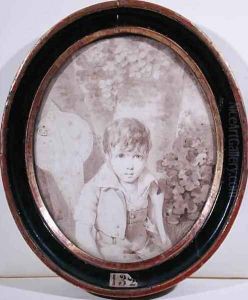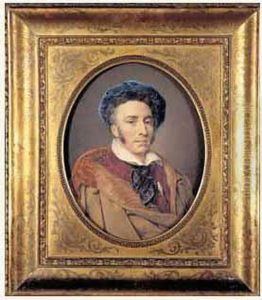Henri Joseph Hesse Paintings
Henri Joseph Hesse was a notable French painter, born in 1781 in Paris, France. His contributions to the art world are primarily rooted in the Neoclassical tradition, a movement that sought to emulate the purity of ancient Greek and Roman art. Hesse's career flourished during a period of significant cultural and political change in France, spanning the aftermath of the French Revolution, the Napoleonic era, and into the Restoration period. Despite the tumultuous times, Hesse managed to carve out a successful career as an artist, largely due to his exceptional skill in portraiture and historical painting.
Hesse's education in art began under the tutelage of prominent artists of the time. He studied at the École des Beaux-Arts in Paris, where he was influenced by the works of Jacques-Louis David, a leading figure in Neoclassical art. Hesse's early works were characterized by their adherence to Neoclassical ideals, focusing on harmony, simplicity, and the portrayal of subjects with idealized beauty. He quickly gained recognition for his talent, especially in portraiture, where his ability to capture the likeness and character of his subjects won him commissions from the French aristocracy and later from the burgeoning bourgeoisie.
Throughout his career, Hesse exhibited his works at the Paris Salon, the official art exhibition of the Académie des Beaux-Arts in Paris. His paintings were well-received, earning him accolades and increasing his visibility among potential patrons. One of his most significant achievements was receiving a medal at the Salon, which solidified his reputation as a leading portraitist of his time. Hesse's historical paintings, which often depicted scenes from French history, were also celebrated for their detailed accuracy and emotional depth.
Despite his success, Hesse's life was not without challenges. The shifting political landscape of France, particularly during the Napoleonic wars and the Restoration, affected the art market and the types of commissions available. Yet, Hesse adapted to these changes, sometimes focusing more on portraiture, which remained in demand. His work provides a fascinating window into the era, capturing the faces and fashions of a society undergoing rapid transformation.
Henri Joseph Hesse passed away in 1849, leaving behind a legacy that has continued to be appreciated by art historians and collectors. His body of work is a testament to the enduring appeal of Neoclassical art and provides valuable insights into the cultural and historical context of early 19th-century France. Today, Hesse's paintings can be found in museums across France and in private collections worldwide, where they continue to be studied and admired for their beauty and historical significance.






